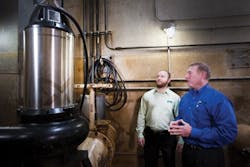Clog Combat
About the author: Robert Montenegro is executive vice president, water utility/municipal, for Grundfos. Montenegro can be reached at [email protected].
Tommy Cook, pump salesman and president of Pumps of Houston, was so confident in the solids-handling performance of a new wastewater pump that he suggested a trial test to prove his claim.
“We had absolutely no doubt that we could significantly eliminate clogs at a number of Houston-area municipal lift stations using the SE solids-handling wastewater pumps from Grundfos,” Cook said. “The problem, however, was convincing the local municipal board of directors of the potential savings offered by new pumps.”
Understanding a board’s proclivity to reduce costs, Cook asked the board to approve a side-by-side comparison. “We said, ‘Give us your worst, most problematic station, and let us install the new pump alongside the existing equipment and see which pump is better at managing solids without clogging,’” Cook said.
The testing ground was a municipal utility district lift station located in suburban Houston. Like many cities, the district outsources management of its lift stations to an outside vendor. Since 1986, the wastewater treatment firm Severn Trent has managed the 1.55-million-gal-per-day wastewater facility located in Harris County, Texas, that serves residents across four separate municipal districts.
Jason Demel, who oversees local operations for Severn Trent, knew that solids-handling pump technology could put an end to the production-halting jams caused by an increasing volume of disposable consumer waste products.
In fact, clogs had become such a problem for the lift station that Demel began tracking the repeated maintenance costs to clear debris from the triplex station’s three 20-hp centrifugal impeller pumps. In the 20 months between September 2013 and May 2015, Demel recorded more than $175,000 in charges that the utility paid to remove clogs from the lift station.
Chronic Clogs
According to Demel, the primary cause of this lift station pump failure is clogging due to “ragging,” or the accumulation of consumer flushables, including feminine products, diapers and wet wipes.
Unlike conventional fabrics that are knitted or woven, many wet wipes (including baby wipes, personal hygiene wipes, cosmetic removal wipes and household cleaning wipes) are manufactured by entangling fibers in a sheet or web structure, and bonding them mechanically, chemically or thermally.
Compared to paper products, these non-woven fabrics, which are manufactured by bonding fibers, can strangle traditional lift station pumps, entangling pump impellers and impeding or totally clogging intake valves. Without enough water to push solids through the system, they tend to build up in the pipe, until “they’re bunched together in what looks like a long rope,” Cook said.
Houston is not the only utility grappling with these issues, according to Cook. He said the reduction of water is causing problems for wastewater systems nationwide. “We did a nationwide study and found that there is a significant reduction of water entering wastewater treatment plants than 10 years ago,” Cook said. “Plants designed for a flow of 1.2 million gal per day are now getting around only 600,000 gal.”
Initially, one pump was installed in each of the two lift stations, but in June 2016, a second pump was added to each.
A Better Impeller
Demel asked Cook to recommend a pump that could handle these issues, and Cook determined that the best hydraulic fit would be the Grundfos SE1.
The pump uses an S-tube impeller: a channel impeller that offers hydraulic efficiencies without compromising free passage of solids. It has no edges, dead zones or cutting functions that can trap debris. “The SE’s impeller just passes whatever comes to it,” Cook said.
The pump’s operation includes a self-clearing mode: The impeller automatically spins backwards and tries to clear itself before signaling that it’s clogged. “It’s exponentially more efficient than older pumps at passing rags and anything else that gets into it,” Cook said.
The pump also has a variable frequency drive. With the right controls, pump speed can be set to match the actual flow at any given time. This means less long-term wear and tear on the internal parts.
Performance Test
The board agreed to Cook’s trial, wanting to see performance data. “When someone makes a savings claim, I always ask them to prove it,” said Jim Denmon, director of the Harris County Municipal Utility District.
For the test case, Demel chose a pair of lift stations located in a 90% residential community serving nearly 4,000 homes, each containing three 1,000-gal-per-minute non-clogging centrifugal pumps—two active and one backup—which had been in place since the 1980s.
Severn Trent installed one solids-handling pump in each of the two stations in May 2015. In June 2016, they put new epoxy liners on the wet wells and installed a second SE pump in each station.
Big Savings
The results have exceeded expectations. Clogging during the test period dropped significantly, as did maintenance needs. “We were de-ragging the old pumps one or more times per week,” Denmon said. “After more than three months in operation, however, the Grundfos pumps haven’t needed de-ragging even once.” These results were so encouraging that the district decided to replace the third pump in each station by the end of the year.
For each of the lift stations, the solids-handling wastewater pumps reduced monthly maintenance costs from an average of $6,415 per month, or more than $76,000 per year, to an average of $2,489 per month. In other words, the drop in de-ragging and repair costs will now save the utility district roughly $3,926 per month, or $47,112 per year—a staggering 61% reduction in maintenance. With each pump costing approximately $25,000, the decline in maintenance costs would pay for three new pumps in only 19 months.
In addition to reducing the amount of service calls, maintaining the clog-resistant pumps easier. “I have been very impressed by the ease of cleaning,” Demel said. His cleaning time was reduced by 56%.
Demel said the new pumps use approximately 20% less energy than the old ones. The expected 30-year lifetime translates to a large reduction in the municipality’s electric bills.
The pump is submersible. The old pumps in the 30-ft.-deep dry well had been damaged by unexpected flooding over the years, requiring motor replacement. The pump’s motor is protected by a waterproof housing to withstand periods of flooding without damage.
Demel is confident that the success of this first case will lead to upgrades in other stations. “The operation manager in charge of this facility absolutely loves these new solids-handling pumps and has gotten the board to approve their use in other facilities based on the stunning savings from this project,” he said.
Demel believes the pumps would be beneficial to all of the 40 lift stations his office manages. “I imagine it will be on my shoulders to push this around to the rest of the company.”
He considers the equipment a viable solution to the increase in ragging problems and higher maintenance burdens faced by utilities. “I know of no other option in our industry that would take care of this problem,” he said.
Watch a video of this project.

